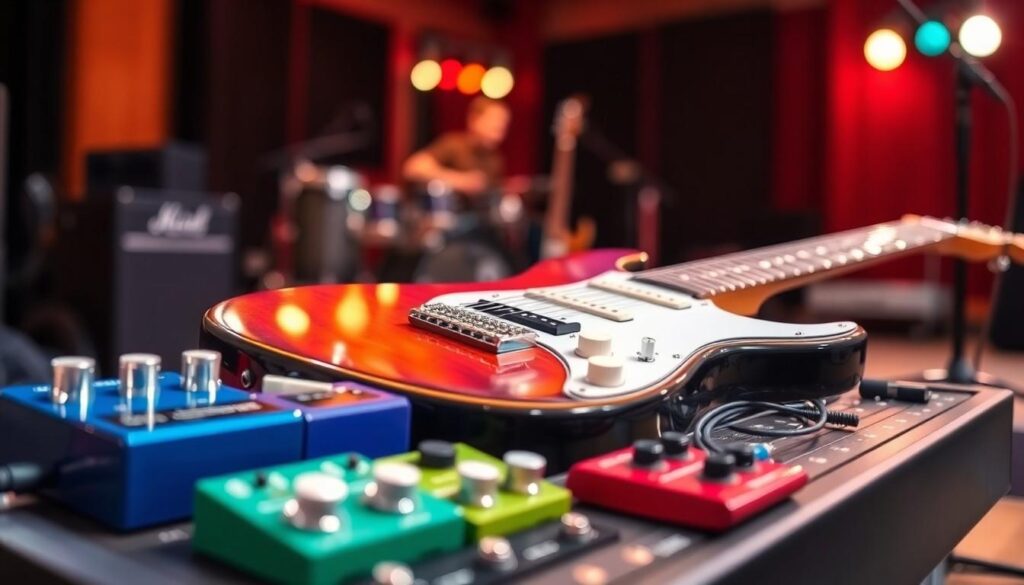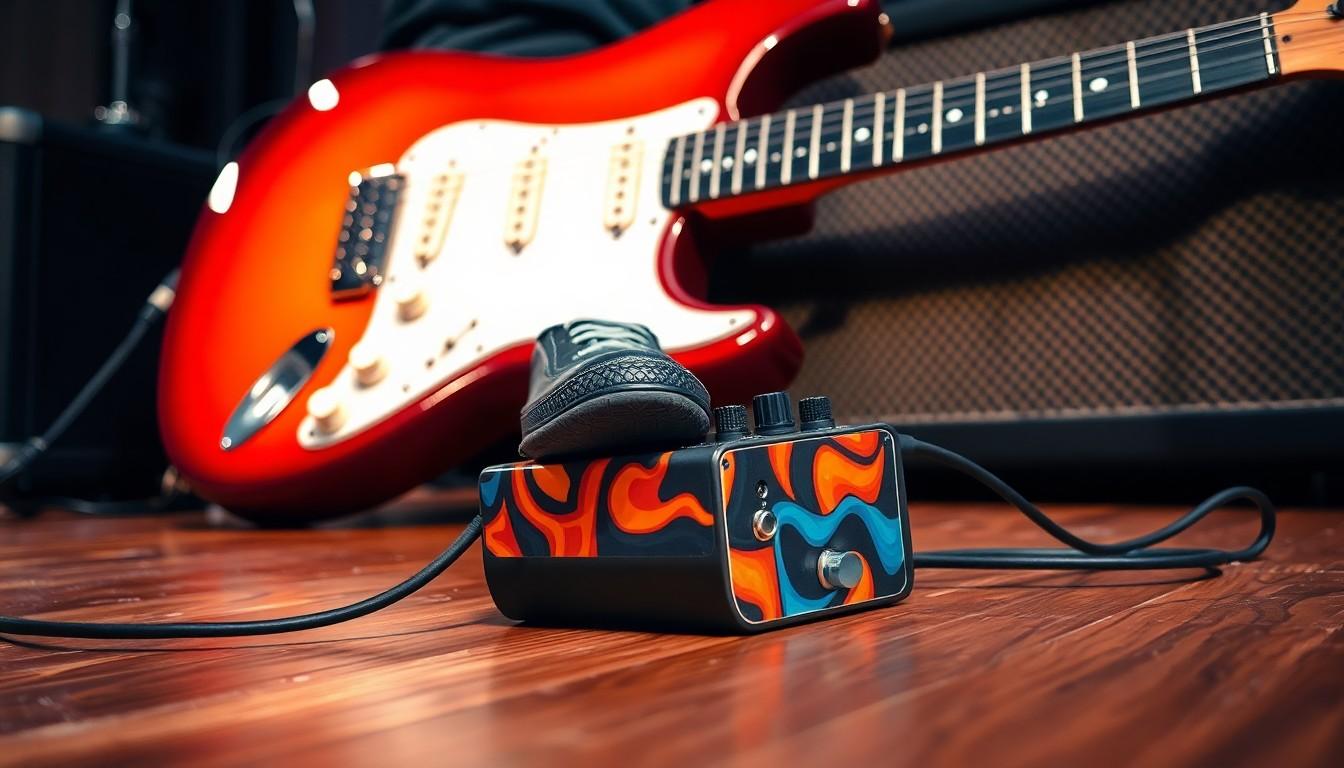
Every guitarist knows that sweet spot when their tone hits just right. But what if you could make those singing leads and funky rhythms even more magical? That’s where compression pedals step in – the unsung heroes of the pedalboard that can transform a good sound into something extraordinary.
Think of a compressor pedal as a musical superhero that evens out your playing dynamics while adding sustain and punch to your tone. Whether you’re channeling your inner Nile Rodgers with disco rhythms or aiming for David Gilmour’s soaring leads these pedals help create that polished professional sound that makes listeners’ ears perk up. In today’s market there’s a perfect compressor for every style and budget – from simple one-knob wonders to sophisticated studio-grade units.
Best Compressor Pedal
A compressor pedal automatically controls audio signal levels by reducing louder sounds and amplifying quieter ones. The pedal creates a more balanced output by monitoring incoming signal strength and adjusting volume accordingly.
The core components of a compressor pedal include:
- Threshold: Sets the volume level where compression begins
- Ratio: Controls the amount of compression applied to signals above threshold
- Attack: Determines how quickly compression engages
- Release: Adjusts how long compression remains active
- Output/Makeup Gain: Compensates for overall volume reduction
Here’s how compression affects different playing dynamics:
| Playing Style | Without Compression | With Compression |
|---|---|---|
| Soft Picking | Low volume, weak | Fuller, audible |
| Hard Picking | Loud, harsh spikes | Controlled, even |
| Sustain | Quick decay | Extended notes |
The compression process follows three main steps:
- Detection: Monitors input signal strength
- Processing: Applies gain reduction based on settings
- Output: Delivers balanced signal with makeup gain
Modern compressor pedals feature different circuit designs:
- Optical (LED/photocell)
- FET (transistor-based)
- VCA (voltage controlled)
- OTA (operational transconductance)
Each circuit type produces distinct compression characteristics while maintaining the original signal’s tonal quality. Advanced models incorporate additional features like blend controls side-chain filters parallel compression options.
Key Features to Look for in a Compressor Pedal

Essential compressor pedal features determine sound-shaping capabilities for optimal tone control. Understanding these key components enables guitarists to select the most suitable pedal for their playing style.
Attack and Release Controls
Attack controls regulate how quickly compression engages when a note is played, measured in milliseconds from 1ms to 100ms. Fast attack times tame aggressive picking transients while slower settings preserve initial note dynamics. Release controls set the duration for compression to disengage after the signal drops below threshold, ranging from 50ms to 1 second. Proper release timing prevents unwanted signal pumping effects while maintaining natural note decay. These parameters work together to shape the dynamic response:
| Control | Range | Primary Use |
|---|---|---|
| Attack | 1-100ms | Transient control |
| Release | 50ms-1s | Sustain shaping |
Blend and Sustain Options
Blend controls mix compressed signal with unprocessed sound from 0-100%, maintaining picking dynamics while adding compression effects. Sustain knobs determine how long notes ring out by adjusting the compression ratio up to 20:1 for infinite sustain. Advanced pedals include parallel compression paths featuring:
- Independent level controls for dry signals
- Multiple blend modes for studio-style compression
- Adjustable sustain curves for different playing styles
- LED gain reduction meters for visual feedback
Many boutique pedals offer preset storage options to save preferred blend sustain combinations for quick recall during performance.
Best Compressor Pedals for Different Budgets
Compressor pedals span a wide price range with distinct features at each price point. Top manufacturers offer options from basic squeeze controls to comprehensive studio-grade compression systems.
Premium Options
The Origin Effects Cali76 Compact Deluxe delivers studio-grade compression in a pedalboard format. This Class A discrete circuitry unit replicates the legendary UREI 1176 with dedicated attack release ratio controls. The Empress Effects Compressor MKII features parallel compression dual band operation LED metering. The Strymon Compadre offers discrete Class A JFET circuitry with studio analog compression plus digital control. Each premium model includes true bypass switching pristine signal quality professional I/O connections.
| Premium Model | Price Range | Key Features |
|---|---|---|
| Cali76 Compact | $350-399 | Class A, 1176-style |
| Empress MKII | $249-299 | Dual band, LED meter |
| Strymon Compadre | $299-349 | JFET, presets |
Mid-Range Choices
The Keeley Compressor Plus provides studio quality compression with a blend control sustain adjustment. The Wampler Ego Compressor features an OTA design with tone shaping options attack release controls. The MXR M87 Bass Compressor includes LED metering input output controls constant headroom technology. These pedals balance professional features with accessible pricing.
| Mid-Range Model | Price Range | Key Features |
|---|---|---|
| Keeley Comp+ | $149-179 | Blend, sustain |
| Wampler Ego | $199-229 | OTA, tone control |
| MXR M87 | $189-219 | LED meter, CHT |
Budget-Friendly Picks
The Boss CS-3 Compression Sustainer delivers reliable compression with level tone sustain controls. The MXR Dyna Comp maintains classic ross style compression in a simple format. The Behringer CS400 offers basic compression functionality at an entry level price point. These models focus on essential features while maintaining usable sound quality.
| Budget Model | Price Range | Key Features |
|---|---|---|
| Boss CS-3 | $99-129 | Level, tone, sustain |
| MXR Dyna Comp | $79-99 | Ross style circuit |
| Behringer CS400 | $29-39 | Basic compression |
Top Compressor Pedals for Specific Music Styles
Genre-specific compression requirements demand distinct pedal characteristics to achieve optimal tone shaping. Each music style benefits from specific compression settings and features that enhance its signature sound.
For Country and Funk
Country and funk players rely on optical compressors for their smooth, transparent compression characteristics. The Origin Effects Cali76 Compact Deluxe delivers the classic studio-grade compression essential for chicken pickin’ and snappy funk rhythms. Keeley Compressor Plus offers dedicated single coil/humbucker switches perfect for country twang. MXR Dyna Comp creates the punchy attack needed for funk’s percussive playing styles through its fast attack times and moderate compression ratios. The Xotic SP Compressor provides blend controls that maintain note clarity while adding sustain for country lead lines.
For Rock and Metal
Heavy music styles demand compressors that control high-gain dynamics without sacrificing tone. The Empress Effects Compressor MKII features parallel compression ideal for maintaining clarity in high-gain scenarios. Wampler Ego Compressor excels at preserving pick attack while smoothing out palm-muted rhythms. The MXR M87 Bass Compressor offers precise control over attack times crucial for metal’s tight rhythmic passages. Boss CS-3 Compression Sustainer provides the sustained leads essential for rock solos through its variable sustain control. These pedals incorporate noise reduction circuits that minimize unwanted hum during high-gain operation.
How to Set Up Your Compressor Pedal
- Position in Signal Chain
- Place the compressor near the start of the signal chain after tuner pedals
- Connect before overdrive distortion pedals for cleaner compression
- Position after filter effects like wah pedals to maintain tonal clarity
- Initial Settings Setup
- Set ratio to 3:1 for balanced compression
- Adjust threshold knob to -20dB
- Keep attack time at 20ms
- Set release time to 100ms
- Position level/makeup gain at unity (12 o’clock)
- Fine-Tuning Process
- Play guitar at varying intensities to test compression
- Adjust threshold until gain reduction meter shows 3-6dB of compression
- Modify attack time for picking response
- Tune release time to match tempo of played music
- Balance output level with bypassed signal volume
- Genre-Specific Adjustments
- Country: Fast attack (5ms) slow release (200ms)
- Rock: Medium attack (20ms) medium release (150ms)
- Metal: Slow attack (30ms) fast release (80ms)
- Funk: Fast attack (10ms) medium release (120ms)
| Parameter | Starting Point | Adjustment Range |
|---|---|---|
| Ratio | 3:1 | 2:1 to 8:1 |
| Threshold | -20dB | -40dB to -10dB |
| Attack | 20ms | 5ms to 50ms |
| Release | 100ms | 50ms to 500ms |
| Output | Unity | -10dB to +10dB |
- LED Monitoring
- Observe gain reduction meter while playing
- Aim for consistent LED movement
- Adjust settings when meter shows excessive compression
- Monitor output level for volume matching
Common Compression Mistakes to Avoid
Setting the ratio too high creates an unnatural squashed sound that lacks dynamic range. Guitarists often compress their signal excessively, resulting in a lifeless tone without character.
Incorrect threshold settings mask the nuances of playing dynamics. Setting thresholds too low compresses every note unnecessarily while setting them too high fails to catch important peaks.
Fast attack times eliminate the natural pick attack, reducing articulation in the playing. Slow release times cause pumping effects when the compressor fails to recover quickly enough between notes.
Improper gain staging leads to unwanted noise or insufficient output levels. Excessive makeup gain introduces unnecessary noise while insufficient levels result in a weak signal.
Poor pedal placement in the signal chain diminishes compression effectiveness. Placing compressors after distortion pedals creates inconsistent gain reduction due to already compressed signals.
These technical missteps commonly affect tone quality:
- Running compression levels above 6:1 for standard guitar applications
- Setting thresholds below -30dB for clean tones
- Using attack times under 5ms with picked notes
- Applying release times longer than 200ms for rhythmic playing
- Positioning the compressor after modulation effects
- Failing to adjust settings between different guitars
- Ignoring the interaction between compression ratio levels
- Missing the balance between attack transients preservation
- Overlooking parallel compression options on capable units
| Parameter | Optimal Range | Common Mistake |
|---|---|---|
| Ratio | 2:1 to 4:1 | Above 6:1 |
| Threshold | -25dB to -15dB | Below -30dB |
| Attack | 5ms to 50ms | Under 5ms |
| Release | 50ms to 200ms | Above 250ms |
Finding the perfect compressor pedal depends on individual playing style budget and musical genre. Whether it’s a high-end Cali76 or a budget-friendly Boss CS-3 there’s a pedal for every guitarist’s needs.
Understanding compression fundamentals and proper pedal setup leads to better tone shaping and more dynamic control. With the right settings and careful consideration of features like attack release and blend controls guitarists can achieve professional-grade sound quality.
The key to success lies in choosing a pedal that matches specific requirements and taking time to learn its functions. Armed with this knowledge any guitarist can enhance their tone and take their playing to the next level.


